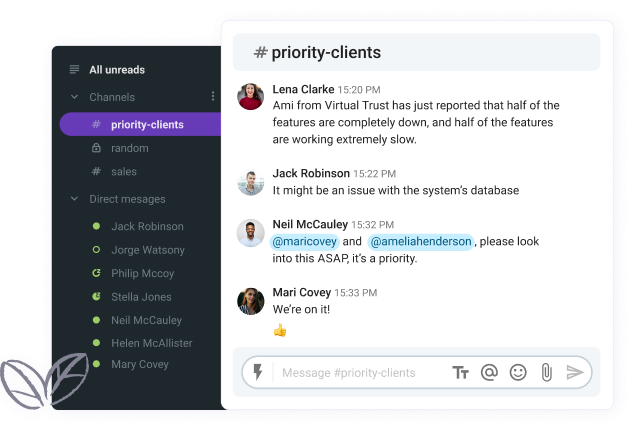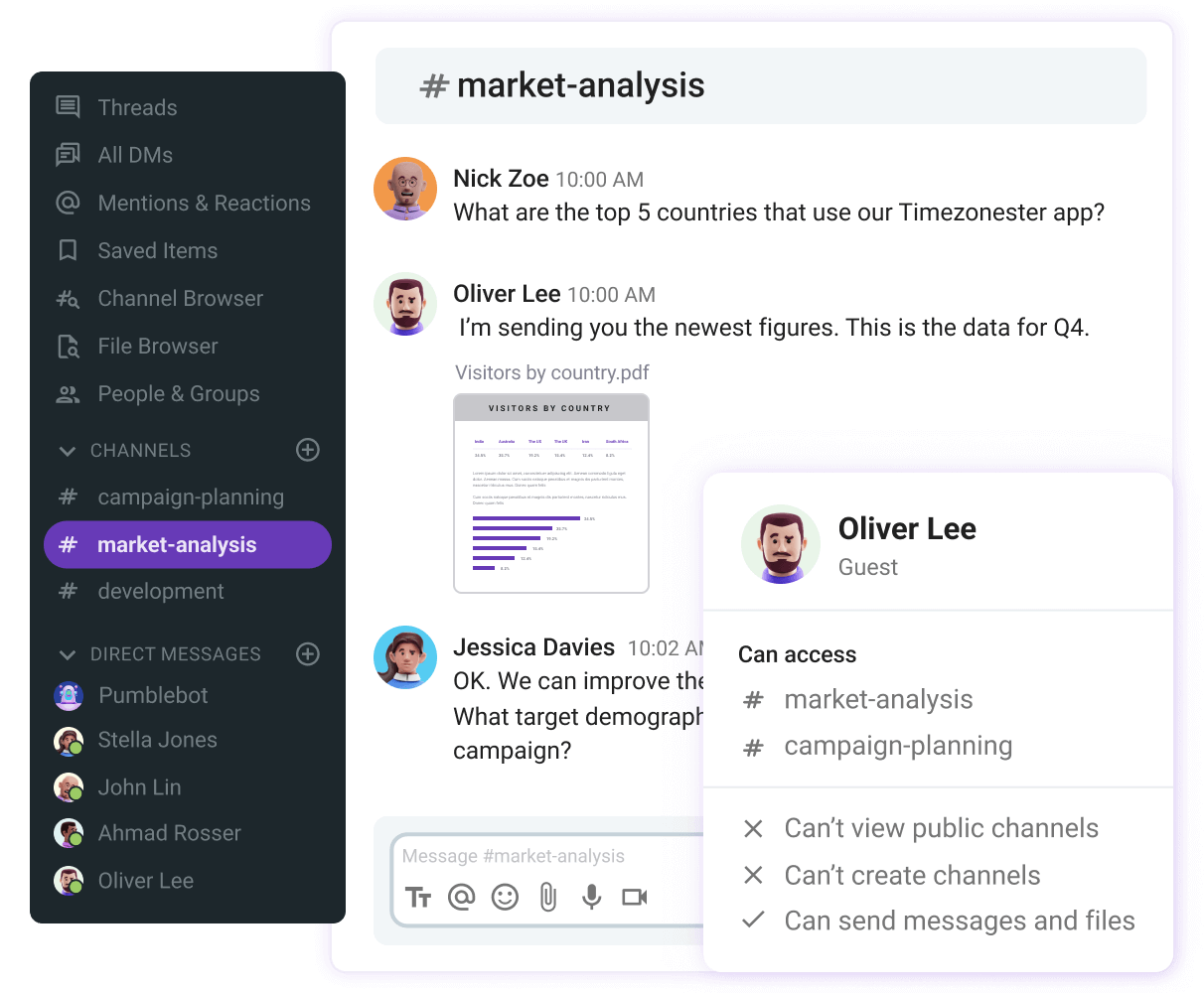Executives might be the most important channels of communication with both external and internal audiences.
As a leader, you are the face of your organization and a reflection of your brand. Therefore, everything you say and do carries immense weight (and consequences).
After all, research has found that CEOs’ observable personalities — including how they interact with the public and media — can negatively affect their company’s stock volatility.
So this article aims to help you understand the importance of executive communication.
Furthermore, it offers practical tips on how to improve it yourself, with examples from communication experts.
Let’s dive in.

Table of Contents
What is executive communication?
Executive communication is a type of organizational communication that comes from the leadership or the executive team — i.e. from the top.
Moreover, executive communication can be:
- Internally oriented — directed at employees
- Externally oriented — directed at all external parties, i.e. clients, partners, or the public
Leadership communication is vital for any organization’s success. It’s more than a way to relay information and directions to your employees and outside parties.
As a leader, your words are far-reaching and often scrutinized. They have the power to influence, alienate, or open. That’s why you need to choose them carefully and deliberately.
If done correctly, executive communication can inspire and motivate.
On the other hand, if it goes badly, it can ruin the future of your organization, as well as your career.
That’s why many leaders have entire communications teams headed by executive communications managers.
They can work closely with executive coaches, media trainers, reputation specialists, and other experts to help tailor their message and align it with the brand.
Executive communication examples
We’ve asked communication experts to share stories from their professional experience working with leaders.
These stories illustrate the importance of effective executive communication, both internal and external.
🔸 Internally oriented executive communication example
The first example comes from Michael Toebe, Founder and Reputation Specialist at Reputation Quality.

“A client once wondered how to best conduct internal communications after a media story that didn’t paint this executive in the most favorable light.
He was caught up in ego, victimization, and defensiveness, all very natural reactions when feeling attacked and embarrassed. He was able to see the gap between what his people might think of him and how he wanted them to view him. He knew the only way to accomplish the latter was to show courage in communication — often a difficult, unwanted ‘ask’ of executives.
After some painful deliberation, he stepped into his conflict and communicated with poise, transparency, humility, responsibility, and remorse, owning his errors and shame, and detailing what specific action he would take to correct it and not repeat it in the future. It was well-received because this approach is so very rare in leadership communication.”
🔸 Externally oriented executive communication example
We were provided the following example by Julie Livingston, PR and Integrated Marketing Expert and Owner at WantLeverage Communications, a PR and integrated marketing consultancy.

“In order to maintain transparency with the media and key targets during a major industry crisis — millions of product recalls of children’s products — I had prepared an executive spokesperson of an industry association for an interview with Good Morning America.
The producer had, as requested, provided questions in advance which provided an opportunity for us to review and prepare our responses. As this was a crisis situation, I prepared the spokesperson for any curveball questions. Unfortunately, the interview quickly changed course and turned into an interrogation. It became a situation where the reporter had a specific story in mind — to vilify the industry and spokesperson for the product recalls — without really hearing the other side of the story.
Yet, because of the intense preparation — we did review key messages and prepare a variety of responses — the spokesperson remained calm and focused. Even as he pressured her, she remained steady and continued to revert back to the messages we had to share with the audience. These included the proactive measures that the industry association and one of its members were taking to rectify the crisis at hand to make sure that children were safe. Not all of our messages made it into the final edited interview, but the pre-interview preparation made a huge difference in the ability of the spokesperson to maintain composure under fire.”
Why is executive communication important?
The examples above showcase some of the benefits of effective executive-level communication. In this section, we’ll take a closer look at those benefits.
✅ Effective executive communication builds trust
Trust is the key ingredient of any successful organization. Research shows that 55% of leaders believe a lack of it directly threatens their company’s growth.
The best way to build trust from the top down is through practicing transparent communication and taking responsibility.
As we have seen from the first example above, the executive regained the trust of his employees when he accepted accountability. Moreover, he embraced a transparent approach to addressing the issue in question.
Had there been radio silence after the incident, or worse, an attempt at a cover-up, the executive would have further perpetuated the issue. This way, he would have completely lost the already fragile trust of his employees.
✅ Effective executive communication boosts engagement
Experts agree that communication is at the core of employee engagement. It’s what keeps the company up and running.
While it’s important that employees communicate among themselves, there also need to be channels for regular communication with the higher-ups. One Gallup research shows that managers can make up to a 70% difference in employee engagement.
It’s clear that a lot of motivation and morale comes from the top down. By regularly communicating with employees, executives nurture a healthy company culture and inspire employees to make an effort.
As in the first example above, executives can also reassure their employees through effective communication in difficult situations. This way, they keep their minds at ease and allow them to stay engaged even in a crisis.
✅ Effective executive communication improves team agility
Gone are the days of siloed organizations where executives can stay in their leadership bubble and rely on trickle-down communication.
Today, effective leaders tailor their messaging to make sure it reaches everyone, no matter their position within the organization. They no longer rely on direct reports to disseminate information.
This way, not only do executives take direct responsibility for their decisions and actions, but they also speed up company processes and improve overall efficiency and agility.
With team chat apps such as Pumble, this cross-functional communication is made easy. All the executive needs to do is consider whom they want to reach and pick the right channel or ping the appropriate user group.
This way, executives also don’t have to wait on their direct reports to deliver a vital piece of info from a specific person in a specific department. They can simply ask for it in the team messaging app and receive an answer directly and immediately.

✅ Effective executive communication is crucial for building a brand image
The voice of the CEO, president, VP, or another public-facing person in the leadership team is the voice of the brand.
It should be at the helm of the company’s PR and marketing efforts and align with them to create a uniform brand voice. This voice dictates how the public perceives your company and its values.
As the example of externally oriented executive communication above shows, it’s not about preparing a word-for-word speech for the public. It’s about working with the communications team to internalize the brand voice and message you want to present to the world.
Had the executive spokesperson only prepared the exact answers to the provided questions, she would have cracked under pressure when the interview took a different turn.
Instead, her communications consultant helped her prepare the general message she wanted to project on behalf of the brand. This framework allowed her to stay on track despite the hostility of the reporter.
So executive communication is essential in building and nurturing brand credibility by projecting a unified message based on the core company values.
✅ Effective executive communication is vital for crisis management
The voice of the company executives is never quite as important as in crisis management. The role of effective communication from the top in times of crisis is pivotal for successfully weathering the storm.
Both examples above show the importance of maintaining composure under pressure in crisis management. And effective communication is essential for achieving that.
In the first example, the executive handled the tricky situation with poise and honesty, winning over his employees.
In the second one, the executive spokesperson remained composed under pressure and managed to avoid a potential PR catastrophe.
It’s a great idea to anticipate such situations and have a plan in place on how to handle internal and external communication in times of crisis.
💡 Pumble pro tip
We have a detailed guide on how to create a crisis communication plan with a bunch of general and specific templates you may find handy:
Tips for improving executive communication
As you can see, leadership communication has the power to make or break your business.
But, if you’re lacking in this department, there’s no need to worry, as effective communication can be learned.
Here are some tips to improve executive communication.
1️⃣ Develop executive communication skills
Effective communicators rely on a variety of soft skills in different situations. However, some of these skills are must-haves for leaders.
They include the following:
- Transparency
- Clarity
- Active listening
- The ability to choose the appropriate style
- Empathy
Transparency
When we asked Micheal Toebe about the essential executive communication skills, he said the following:

“It’s vitally important to communicate with poise, transparency, directness, an eye on the objective, humanity, and compassion. Don’t speak in a robotic, corporate-speak manner or your audience will likely listen less effectively and not be as influenced or persuaded well.”
No matter how skilled an orator you are, people can smell dishonesty from a mile away. So you can wrap it up and put a bow on it, but if you’re not being transparent and direct, no one will care.
Transparency fosters trust, and trust is the cornerstone of lasting success, both internally and externally.
Transparent communication is important for the free flow of information and trust, but it also makes you a lot more likable in the eyes of your audience, no matter who they are.
Clarity
Getting lost in the rhetoric is not a great way to steer your communication efforts. You need to communicate with clarity and provide all the information your audience needs to know.
Be as specific as you can so that everyone can understand your message, intentions, and goals.
Active listening

“Lead through questions and don’t manage through statements.”
This is the number one tip for effective executive communication Peter Boolkah, Business Coach at Forbes, shared with us.
When we asked him about the most important executive communication skill, his answer was straightforward:

“The ability to listen and ask questions without passing judgment. Too many executives don’t listen and just give out commands.”
The message is clear: listen before you speak.
If you perfect the art of active listening, you can better calibrate your messaging as well. By lending an ear to your employees and asking for regular upward feedback, you can learn a lot of things:
- what employees need and how you can provide it,
- potential problems lurking on the fringe,
- things that need to be addressed,
- the general sentiment toward you, etc.
The same goes for external communication. You should always listen to what the public has to say about you, analyze the general sentiment, and fine-tune your message accordingly.
The ability to choose the appropriate style
You may have a preferred communication style, but as a leader, you also need to be able to switch between different styles according to the occasion.
Everyone communicates in different ways, and people respond differently to different stimuli. Likewise, different groups respond well to different styles.
For example, you will probably use one style to share good news with your staff and another to make an announcement on a TV news channel. In the former case, you can be more informal and laid-back than in the latter.
💡 Pumble Pro Tip
If you want to know more about various leadership communication styles, you can read up on them in our comprehensive guide:
Empathy
Research shows that empathy may be the single most important leadership skill in today’s world.
By showing empathy, you:
- strengthen your relationships with your staff
- promote a healthy company culture
- boost employee engagement
Empathy also makes everything you say sound more genuine because — well, because it is. If you’re whole-heartedly behind the message you’re delivering, people will see that you care.
2️⃣ Know your audience
Before you can find the best way to present your message, you first need to be thoroughly familiar with your audience.
Here’s what Mr. Toebe has to say about the importance of knowing your audience:

“What are the objectives you wish to accomplish? What matters to your audience and what would be beneficial to them that you can convey that will help you and the organization achieve the desired agreement, action, progress, and goal? Focus on the relationship with the audience and their psychology and human needs. If you think that’s not important, you’re handicapping yourself, your communication, and what you hope to accomplish.”
So it’s not only about what you want to convey, but you also need to think about who you want to convey the message to. That will help you determine your approach.
3️⃣ Think about how your brand fits the context
Whenever you’re entering a communication situation, you need to think about how your personal and professional brand fits in the given context.
How do your core values and goals correspond to the subject matter or message at hand?
What preconceptions does the audience have about you?
Why do they have them?
What are the interests of your audience/interlocutors?
Understanding the context around the communication situation will help you respond well, even to unexpected challenges or unpleasant surprises.
For example, if a reporter is giving you a hard time, you’ll know where the antagonism is coming from. This way, you’ll be able to respond carefully with the subtext in mind and not risk unwittingly saying something that might put you in an unfavorable position.
4️⃣ Communicate regularly
Whether it’s internally or externally oriented, executive communication needs to be consistent — not just in terms of messaging, but also in regularity.
With that in mind, it’s a great idea to have an executive communication plan and stick to it.
➡️ Internally oriented executive communication plan
So how do you prepare this plan?
In essence, there’s no one-size-fits-all approach.
However, based on his professional experience spanning decades, Peter Boolkah proposes a simple solution that works extraordinarily well for his clients:

“Just follow a simple communication rhythm. I like the system used in ‘Scaling Up’ by Verne Harnish. Have daily and weekly huddles followed by monthly, quarterly, and yearly offsite meetings where goals and commitments are regularly reviewed.”
Here’s a breakdown of the basic meetings structure Verne Harnish presents in his book Scaling Up:
- Daily huddles — up to 15 minutes; for updates, daily issues, and hurdles.
- Weekly meetings — from 60 to 90 minutes; for discussing quarterly progress and priorities and addressing one or two specific issues.
- Monthly meetings — half-day to a whole day; all managers gather to collaborate and address big issues.
- Quarterly and annual meetings — from 1 to 3 days; offsite meetings for discussing plans and goals.
💡 Pumble pro tip
If you want to take a more detailed approach to internal communication, we have plenty of templates to help you tailor your approach depending on the situation:
➡️ Externally oriented executive communication plan
In preparation for externally oriented communication, executives often rely on the assistance of communications professionals to help them prepare a strategy.
Julie Livingston has shared with us a formula that, in her professional experience, works best for her clients:

“As a communications professional, my job is to build a relationship so that person will feel comfortable and confident in sharing ideas and reaching out to me for counsel. Therefore, the starting point for writing an executive communications plan is getting to know the executive and building trust. What is her/his personality like? What does the organization wish to accomplish? How can I help her/him to shine? What subjects does s/he have a track record in? What are the issues s/he would prefer to avoid?
In preparation, I will spend time looking at their past media appearances, town halls, speaking engagements as well as their social media, especially LinkedIn. I’ll closely analyze their messaging, oft-used phrases and tone as well as their facial expressions and body language. I’ll share what I think they excel at and areas we could strengthen by working on them together.
Then, I’ll sketch out an annual plan designed to build momentum and hit specific milestones throughout the year. This will include monthly and quarterly goals and activities. We’ll also establish success metrics such as brand positioning, key message replay, tone, etc. so we can analyze program results.”
Her approach is thorough and leaves no room for error, as any public-facing mistake can spiral into a PR disaster.
5️⃣ Use appropriate communication channels
Take the time to evaluate the communication channels matrix in your organization and if it’s effective.
Pay close attention to the channels you’re using to communicate with your employees and managers.
This is especially important if you’re running a remote or hybrid team.
You need to think about the best channels for specific purposes.
For example, what will you discuss in meetings and what issues can you leave out for the team chat?
What’s the most effective way to break out announcements?
What does your feedback system look like, and does it need revision?
Ask these questions when reviewing your communication channels and find the flaws in your system.
💡 Pumble pro tip
You can create an internal communication channel matrix plan so that everyone in the organization knows how to use the available channels the best way. You can find the appropriate temple in our guide on internal communication planning:
6️⃣ Take executive communication training
Ultimately, it can’t hurt to brush up your communication skills and work with professionals to build up your confidence.
There are various executive communication courses you can take either in person or online at your own convenience.
Even if you consider yourself a skilled communicator, you might get some fresh ideas and insights from this kind of course.
Master the art of executive communication with Pumble
As you have seen above, executive communication is crucial for navigating the corporate ship through the seas of the business world.
Hence, executives need a business messaging app like Pumble, to fulfil their communication needs.
Pumble enables efficient 1-on-1 communication thanks to its features such as:
Of course, all of the aforementioned communication channels can be used for group communication or meetings — a group call is just a click away, as are group DMs.
Successful executive communication can help you grow your business, but the opposite can hurt your brand.
Luckily, Pumble is there to meet all your needs and ensure seamless communication — internally and externally. With features like unlimited file sharing and unlimited message history, Pumble ensures all your conversations are saved forever — which might come in handy from time to time.
What’s more, Pumble also takes care of all your external communication needs. With its guest access feature, Pumble allows you to invite external partners into your workspace, give them various permissions, and interact and share information with them.

Overall, there are a plethora of Pumble features that make executives’ lives easier — so why not give it a try?




